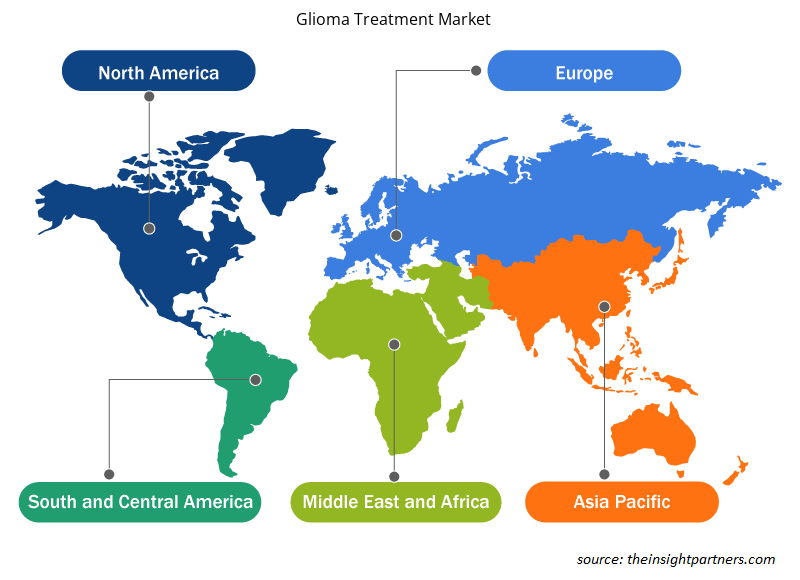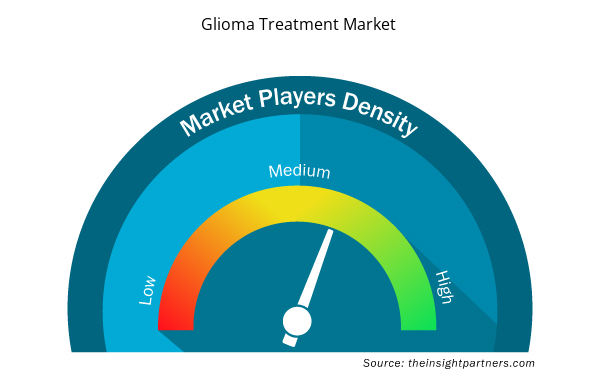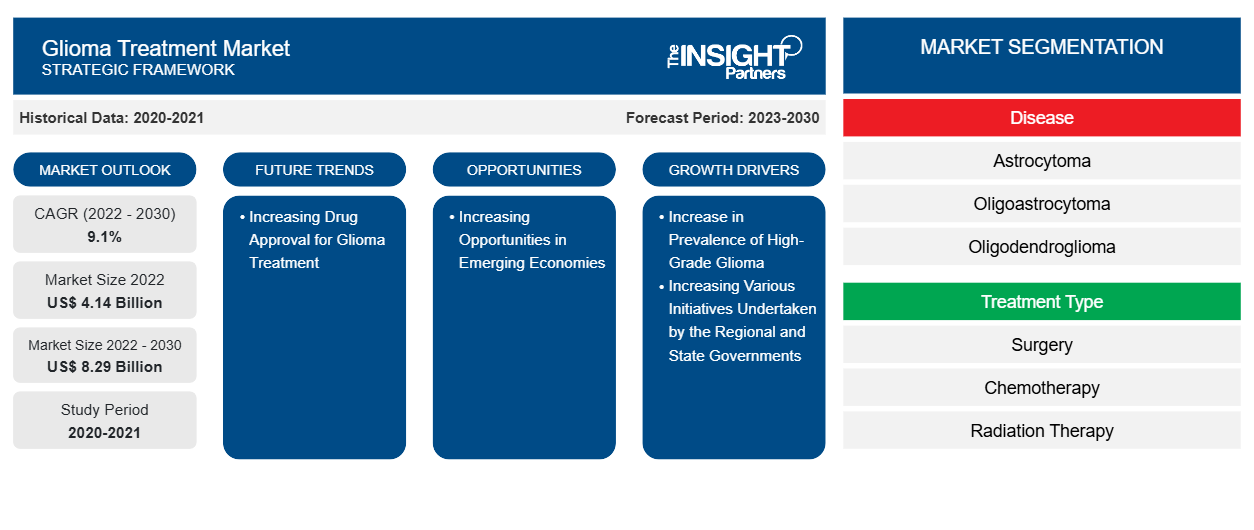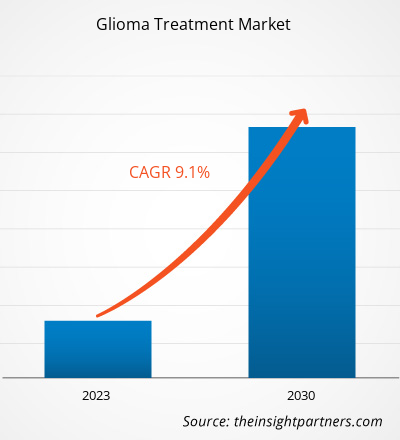[研究报告] 2022 年神经胶质瘤治疗市场收入价值 41.39 亿美元,预计到 2030 年神经胶质瘤治疗市场规模将达到 82.913 亿美元。预计 2022-2030 年期间的复合年增长率为 9.1%。
市场洞察和分析师观点:
神经胶质瘤是一种涉及大脑和脊髓的广泛肿瘤,与大脑功能中的神经胶质细胞有关,根据肿瘤的位置和严重程度,可能会致命。星形细胞瘤、脑干神经胶质瘤、室管膜瘤、混合性神经胶质瘤、少突神经胶质瘤和视神经通路神经胶质瘤是各种类型的神经胶质瘤。常见的神经胶质瘤症状包括头痛、恶心、呕吐、精神错乱和脑功能下降。神经胶质瘤可以通过多种方式治疗,包括神经胶质瘤放射治疗、化学疗法、神经胶质瘤靶向治疗和手术。后期临床管线药物可能为神经胶质瘤提供有效的治疗方法。
增长动力和机遇:
地方和州政府为患者提供治疗机会的举措
2021 年 12 月,患者访问网络 (PAN) 基金会和美国脑肿瘤协会宣布建立新的合作伙伴关系,为胶质母细胞瘤患者提供每年高达 1,600 美元的服务经济援助。此外,胶质瘤治疗市场的领先公司专注于推出新产品和开发现有产品。2020 年 12 月,CNS Pharmaceuticals, Inc. 宣布食品和药物管理局批准使用贝柔比星治疗多形性胶质母细胞瘤患者。此外,食品和药物管理局于 2021 年 8 月将 Lantern Pharma Inc. 的 LP-184 指定为孤儿药,用于治疗多形性胶质母细胞瘤和其他恶性胶质瘤。 2020 年 5 月还举办了一场关于多形性胶质母细胞瘤 (GBM) 以及 Lantern Pharma 的 LP-184 治疗 GBM 和其他类型脑癌的潜力的网络研讨会。因此,地区和州政府为让患者获得新疗法所做的努力加速了胶质瘤治疗市场的增长。
新兴经济体医疗保健领域的进步
巴西、俄罗斯、印度、中国和南非(金砖国家)是世界上增长最快的经济体之一。预计这些国家以及其他发展中经济体的医疗保健行业将在未来几年迅速扩张。预期增长归因于客户需求的变化、对医疗保健服务认识的提高以及人口老龄化的持续增加。随着医疗保健行业的蓬勃发展,全球脑癌诊断市场在未来几年可能会大幅增长。此外,政府对医疗设施的支出增加和消费者购买力的提高也促进了发展中国家医疗保健行业的增长。
由于正在进行的临床研究、集中的医疗机构、高素质和高度积极性的劳动力以及出色的临床试验设施,亚洲国家的科学能力正在不断增长。此外,亚太地区的许多国家都拥有庞大而多样化的患者群体,全球约 60% 的人口居住在该地区。亚太地区遵循美国和欧盟监管机构制定的治疗指南来治疗疾病,这为大量快速招募患者提供了坚实的前景。因此,亚太地区发展中国家不断增长的医疗保健行业为胶质瘤治疗市场参与者扩大业务创造了更好的机会。
定制此报告以满足您的需求
您可以免费定制任何报告,包括本报告的部分内容、国家级分析、Excel 数据包,以及为初创企业和大学提供优惠和折扣
- 获取此报告的关键市场趋势。这个免费样品将包括数据分析,从市场趋势到估计和预测。
报告细分和范围:
“全球胶质瘤治疗市场”细分为疾病、治疗类型、等级、最终用户和地域。根据疾病,胶质瘤治疗市场细分为星形细胞瘤、少突星形细胞瘤和少突胶质细胞瘤。根据治疗类型,胶质瘤治疗市场细分为手术、化疗、放射治疗和其他。按等级划分,全球胶质瘤治疗市场分为低级和高级。2022 年,高级细分市场占据了更大的市场份额。按最终用户划分,胶质瘤治疗市场分为医院和诊所以及门诊手术中心。从地理上看,胶质瘤治疗市场分为北美(美国、加拿大和墨西哥)、欧洲(德国、法国、意大利、英国、俄罗斯和欧洲其他地区)、亚太地区(澳大利亚、中国、日本、印度、韩国和亚太其他地区)、中东和非洲(南非、沙特阿拉伯、阿联酋和中东和非洲其他地区)以及南美洲和中美洲(巴西、阿根廷和南美洲和中美洲其他地区)。
节段分析:
根据疾病,神经胶质瘤治疗市场细分为星形细胞瘤、少突星形细胞瘤和少突神经胶质瘤。2022 年,星形细胞瘤细分市场占据了最大的市场份额,预计在 2022-2030 年期间的复合年增长率将达到 9.4%。星形细胞瘤也称为恶性神经胶质瘤,通常发生在大脑的大脑半球。间变性星形细胞瘤是一种罕见的恶性脑肿瘤。星形细胞瘤由星形胶质细胞(星形脑细胞)发展而来。星形胶质细胞和类似细胞称为神经胶质细胞,它们形成的组织称为神经胶质组织,在大脑或脊髓中发育。来自神经胶质组织的肿瘤包括星形细胞瘤,称为神经胶质瘤。间变性星形细胞瘤的症状因肿瘤部位和大小而异。间变性星形细胞瘤的治疗方法是最大限度的手术切除,然后进行放射治疗。治疗方法可能包括神经外科手术、放射治疗或化疗的组合。
Avid Bioservices, Inc.、Merck Sharp & Dohme Corp.、Mylan NV、Novartis AG 和 F. Hoffmann-La Roche Ltd. 是提供用于治疗胶质瘤产品的知名企业。提高公众对这种疾病及其治疗的认识的活动激增,再加上这种疾病的患病率不断上升,是推动胶质瘤治疗市场增长的主要因素之一。此外,在间变性星形细胞瘤细分市场运营的公司可能会从不断增加的研发工作和新的、尚未开发的细分市场中获得增长机会。
根据治疗类型,神经胶质瘤治疗市场细分为手术、化疗、放射治疗和其他治疗。其他治疗包括靶向药物治疗、电场和磁场以及联合治疗。2022 年,手术部分占据了神经胶质瘤治疗市场的最大份额。据估计,在 2022-2030 年期间,该领域的复合年增长率将达到 9.7%。手术是最受欢迎的技术,因为它可以完全切除肿瘤。计算机断层扫描 (CT) 和磁共振成像 (MRI)可帮助神经外科医生定位并精确切除大脑或脊髓的肿瘤。外科医生通过打开颅骨到达肿瘤部位来进行开颅手术。外科手术可以减少脑内实体肿瘤组织的数量;去除肿瘤中心可能对放射和/或化疗有抗性的细胞;并降低颅内压。通过减瘤,外科手术可以延长某些患者的生命并提高剩余生命的质量。
全球胶质瘤治疗市场按级别分为低级别和高级别。2022 年,高级别细分市场占据了更大的市场份额。据估计,在 2022-2030 年期间,复合年增长率将达到 9.4%。高级别胶质瘤的级别为 3 或 4,表明它们更具侵袭性,并更快地生长到大脑或脊髓中,这使得它们的诊断和治疗变得困难。高级别胶质瘤可能无法治愈。手术、放疗和靶向治疗可以减缓肿瘤生长并有助于缓解症状。由于大多数类型的高级别胶质瘤没有治愈方法,因此鼓励许多人参加临床试验。目前正在进行多项研究,以更好地了解高级别肿瘤,从而开发更有效的治疗方法或疗法。高级别胶质瘤是儿童中第二常见的恶性(癌性)脑肿瘤类型。
按最终用户划分,胶质瘤治疗市场分为医院和诊所以及门诊手术中心。2022 年,医院和诊所部门占据了更大的市场份额,预计在 2022-2030 年期间将实现 9.2% 的显着复合年增长率。医院和诊所是初级医疗保健中心,通过雇用合格的医疗和保健人员为患者提供便捷的服务和最佳护理。大多数医院提供的胶质瘤治疗都包含在保险政策中,这鼓励患者在医院接受治疗。此外,术后护理以最佳方式提供,以防止进一步的并发症。由于所有服务都在同一屋檐下提供,因此医院在世界各地受到广泛青睐。此外,各国拥有多家医院,患者可以从不同的治疗方案中进行选择。接触全球趋势、可支配收入增加和报销流程便捷是导致脑癌患者到医院就诊次数增加以及随后进行的脑癌手术数量激增的常见因素。医院的现有基础设施可用于为各种脑癌病例提供高质量的护理,因为他们可以使用先进的医疗设备。医院部门估计在胶质瘤治疗市场中占有相当大的份额,因为大多数新兴国家和发达国家的患者更喜欢到医院治疗与健康相关的问题。此外,发展中国家医院数量的增加、先进诊断平台的采用以及医院可及性的提高将为医院部门在 2022-2030 年期间胶质瘤治疗市场的增长提供有利可图的机会。
区域分析:
从地理上看,神经胶质瘤治疗市场分为北美、欧洲、亚太地区、中东和非洲以及南美和中美洲。欧洲的神经胶质瘤治疗市场分为法国、德国、意大利、西班牙、英国和欧洲其他地区。该地区占据全球市场的第二大份额,这可以归因于脑瘤病例数量的增加、法国脑瘤治疗技术的进步、英国神经系统疾病患病率的增加以及德国医疗保健投资的激增。英国的医疗保健行业可以使用完善的先进医疗技术和设备。根据英国国家医疗服务体系的数据,英国每年有超过 11,000 人被诊断出患有脑瘤,其中近 50% 的肿瘤是癌症。根据 Globocan 2020 的数据,英国记录了约 7,697 例新的脑癌和中枢神经系统癌症病例。由于发病率的迅速上升,一些私人和政府组织正在投资癌症研究。根据英国癌症研究中心 2021 年 4 月发布的脑肿瘤和儿童癌症研究相关书面证据 (BCCR0001),英国癌症研究中心自 2018 年以来已承诺拨款 3545 万美元,通过资助脑肿瘤研究、启动卓越中心和放射研究网络来鼓励脑肿瘤研究。该中心在 2019-2020 年投资 1520 万美元用于脑肿瘤研究,投资 1112 万美元用于影响儿童和青少年的癌症研究,成为英国脑肿瘤领域最大的研究资助者之一。
欧洲拥有完善的医疗保健系统,可为各种医疗状况提供世界一流的诊断和治疗服务。此外,基础设施的发展预计将增加对医院技术先进的医疗实践的需求。欧盟国家将其 GDP 的近 10.9% 用于医疗保健系统。因此,医疗保健发展的上升可能会有利于 2022-2030 年欧洲胶质瘤治疗市场的增长。该地区人均收入高,医疗保健基础设施先进,这意味着对广泛的尖端医疗治疗和诊断的需求。
俄罗斯、波兰、奥地利、瑞士、瑞典、挪威、丹麦、比利时和荷兰是欧洲其他地区的主要国家。癌症病例的增加导致对神经胶质瘤治疗的需求,以及使用新技术先进医疗设施的医院数量的增加,可能会为欧洲其他地区的神经胶质瘤治疗市场带来巨大的增长机会。人口增长、经济繁荣、吸烟者数量的增加(脑癌的风险因素)、对更快诊断的需求激增以及诊断设备的改进是推动欧洲其他地区神经胶质瘤治疗市场的关键因素。
行业发展和未来机遇:
以下列出了全球胶质瘤治疗市场的主要参与者采取的各种举措:
- 2023 年 7 月,F. Hoffmann-La Roche 开发了 RG-6156,该产品正在临床开发中,目前处于多形性胶质母细胞瘤 (GBM) 的 I 期。EGFRvIII x CD3 (RG6156) 是一种 T 细胞双特异性抗体,可与肿瘤细胞上的 EGFRvIII 和 T 细胞上的 CD3 结合。EGFRvIII 是一种激活性 EGFR 突变,可导致致瘤性增加,在约 30% 的胶质母细胞瘤 (GBM) 中表达。
- 2022 年 10 月,Amneal 在美国推出了首个生物仿制药 ALYMSYS(贝伐单抗)。美国的 ALYMSYS(贝伐单抗)是一种血管内皮生长因子抑制剂,用于治疗成人复发性胶质母细胞瘤以及其他癌症治疗。
- 2021 年 8 月,Azurity Pharmaceuticals 收购了 Arbor Pharmaceuticals。合并后的公司以 Azurity 的名义运营,将拥有一系列产品,满足心血管、中枢神经系统、内分泌、胃肠道和机构市场患者尚未满足的需求。
胶质瘤治疗市场区域洞察
Insight Partners 的分析师已详尽解释了预测期内影响胶质瘤治疗市场的区域趋势和因素。本节还讨论了北美、欧洲、亚太地区、中东和非洲以及南美和中美洲的胶质瘤治疗市场细分和地理位置。

- 获取胶质瘤治疗市场的区域特定数据
胶质瘤治疗市场报告范围
| 报告属性 | 细节 |
|---|---|
| 2022 年市场规模 | 41.4亿美元 |
| 2030 年市场规模 | 82.9亿美元 |
| 全球复合年增长率(2022 - 2030 年) | 9.1% |
| 史料 | 2020-2021 |
| 预测期 | 2023-2030 |
| 涵盖的领域 | 按疾病分类
|
| 覆盖地区和国家 | 北美
|
| 市场领导者和主要公司简介 |
|
胶质瘤治疗市场参与者密度:了解其对业务动态的影响
胶质瘤治疗市场正在快速增长,这得益于终端用户需求的不断增长,而这些需求又源于消费者偏好的不断变化、技术进步以及对产品优势的认识不断提高等因素。随着需求的增加,企业正在扩大其产品范围,进行创新以满足消费者的需求,并利用新兴趋势,从而进一步推动市场增长。
市场参与者密度是指在特定市场或行业内运营的企业或公司的分布情况。它表明在给定市场空间中,相对于其规模或总市场价值,有多少竞争对手(市场参与者)存在。
在胶质瘤治疗市场运营的主要公司有:
- F. 霍夫曼-罗氏有限公司
- Arbor Pharmaceuticals, LLC
- 默克公司
- 太阳制药工业有限公司
- 安进公司
免责声明:上面列出的公司没有按照任何特定顺序排列。

- 了解胶质瘤治疗市场顶级关键参与者概况
COVID-19 影响:
在新冠疫情爆发之前,为了有效治疗胶质瘤,人们不断开展研发活动,包括手术切除,然后进行放化疗和化疗,以提高患者的存活率。在美国国立卫生研究院的资助下,市场的主要参与者专注于各种增长战略;例如,研发纳米技术以寻找治疗胶质瘤的方法。由于新冠疫情爆发后治疗重点发生了变化,这些活动被推迟了一段时间。
COVID-19 疫情扰乱了医疗体系,人们开始担心其对非 COVID 疾病状况的后续影响。癌症诊断和治疗具有时间敏感性,很可能受到这些疾病的显著影响。COVID-19 疫情对各癌症学科的活动产生了不利影响。此外,儿童恶性脑肿瘤具有快速生长的特点,需要早期诊断和适当治疗。因此,延迟或改变治疗可能会损害其有效性并降低患者的生存率。由于对 SARS CoV2 感染的恐惧和压力,脑肿瘤儿童决策过程的变化可能会在一定程度上对其最终结果产生负面影响。
竞争格局和重点公司:
全球神经胶质瘤治疗市场的一些知名参与者包括 F. Hoffmann-La Roche Ltd;Arbor Pharmaceuticals, LLC;Merck and Co., Inc.;Sun Pharmaceutical Industries Ltd;Amgen Inc.;Teva Pharmaceutical Industries Ltd.;Pfizer Inc.;Amneal Pharmaceuticals, LLC;Karyopharm Therapeutics, Inc. 和 Bristol Mayers Squibb Company。这些公司专注于新产品的推出和地域扩张,以满足全球不断增长的消费者需求并增加其专业产品组合的范围。他们在全球拥有广泛的影响力,这使他们能够服务于大量客户,从而增加他们的市场份额。该报告提供了神经胶质瘤治疗市场前景的趋势分析,强调了各种参数,例如技术进步、市场动态和全球主要市场参与者的竞争格局分析。
- 历史分析(2 年)、基准年、预测(7 年)及复合年增长率
- PEST 和 SWOT 分析
- 市场规模价值/数量 - 全球、区域、国家
- 行业和竞争格局
- Excel 数据集


- Biopharmaceutical Contract Manufacturing Market
- Sterilization Services Market
- Saudi Arabia Drywall Panels Market
- Single Pair Ethernet Market
- Europe Industrial Chillers Market
- Glycomics Market
- Data Annotation Tools Market
- Military Rubber Tracks Market
- Trade Promotion Management Software Market
- Emergency Department Information System (EDIS) Market

Report Coverage
Revenue forecast, Company Analysis, Industry landscape, Growth factors, and Trends

Segment Covered
This text is related
to segments covered.

Regional Scope
North America, Europe, Asia Pacific, Middle East & Africa, South & Central America

Country Scope
This text is related
to country scope.
常见问题
The global glioma treatment market, by treatment type, is segmented into surgery, chemotherapy, radiation therapy, and others. The other treatments include targeted drug therapy, electric and magnetic fields, and combination therapies. In 2022, the surgery segment held the largest share of the glioma treatment market. It is further estimated to register a significant CAGR during the forecast period.
Global glioma treatment market is segmented by region into North America, Europe, Asia Pacific, the Middle East & Africa, and South & Central America. North America is likely to continue its dominance in the glioma treatment market during 2022–2028. The US holds the largest share of the market in North America and is expected to continue this trend during the forecast period.
Companies operating in the market are F. Hoffmann-La Roche Ltd; Arbor Pharmaceuticals, LLC; Merck and Co., Inc.; Sun Pharmaceutical Industries Ltd; Amgen Inc.; Teva Pharmaceutical Industries Ltd.; Pfizer Inc.; Amneal Pharmaceuticals, LLC; Karyopharm Therapeutics, Inc.; and Biocon Ltd.
Glioma is a condition that covers a broad category of brain and spinal cord tumors that concern the glial cells in the brain function and can be fatal depending on the location and severity of the tumor. Astrocytoma, brainstem gliomas, ependymoma, mixed gliomas, oligodendrogliomas, and optic pathway gliomas are the various types of gliomas. Common glioma symptoms include headache, nausea, vomiting, confusion, and a decline in brain function. Glioma can be treated in a variety of ways which include radiation therapy for glioma, chemotherapy, glioma-targeted therapy, and surgery. Effective treatment of glioma may be available from late clinical pipeline drugs.
Based on disease, the glioma treatment market is segmented into astrocytoma, oligoastrocytoma, and oligodendroglioma. In 2022, the astrocytoma segment held the largest share of the market. The same segment is estimated to record at a significant CAGR of during the forecast period.
Increasing various initiatives undertaken by the regional and state governments to provide patients access to treatment and increase in prevalence of high-grade glioma are the key driving factors behind the market development.
Trends and growth analysis reports related to Life Sciences : READ MORE..
The List of Companies - Glioma Treatment Market
- F. Hoffmann-La Roche Ltd
- Arbor Pharmaceuticals, LLC
- Merck and Co., Inc.
- Sun Pharmaceutical Industries Ltd
- Amgen Inc.
- Teva Pharmaceutical Industries Ltd.
- Pfizer Inc.
- Amneal Pharmaceuticals, LLC
- Karyopharm Therapeutics, Inc.
- Bristol Mayers Squibb Company
The Insight Partners performs research in 4 major stages: Data Collection & Secondary Research, Primary Research, Data Analysis and Data Triangulation & Final Review.
- Data Collection and Secondary Research:
As a market research and consulting firm operating from a decade, we have published and advised several client across the globe. First step for any study will start with an assessment of currently available data and insights from existing reports. Further, historical and current market information is collected from Investor Presentations, Annual Reports, SEC Filings, etc., and other information related to company’s performance and market positioning are gathered from Paid Databases (Factiva, Hoovers, and Reuters) and various other publications available in public domain.
Several associations trade associates, technical forums, institutes, societies and organization are accessed to gain technical as well as market related insights through their publications such as research papers, blogs and press releases related to the studies are referred to get cues about the market. Further, white papers, journals, magazines, and other news articles published in last 3 years are scrutinized and analyzed to understand the current market trends.
- Primary Research:
The primarily interview analysis comprise of data obtained from industry participants interview and answers to survey questions gathered by in-house primary team.
For primary research, interviews are conducted with industry experts/CEOs/Marketing Managers/VPs/Subject Matter Experts from both demand and supply side to get a 360-degree view of the market. The primary team conducts several interviews based on the complexity of the markets to understand the various market trends and dynamics which makes research more credible and precise.
A typical research interview fulfils the following functions:
- Provides first-hand information on the market size, market trends, growth trends, competitive landscape, and outlook
- Validates and strengthens in-house secondary research findings
- Develops the analysis team’s expertise and market understanding
Primary research involves email interactions and telephone interviews for each market, category, segment, and sub-segment across geographies. The participants who typically take part in such a process include, but are not limited to:
- Industry participants: VPs, business development managers, market intelligence managers and national sales managers
- Outside experts: Valuation experts, research analysts and key opinion leaders specializing in the electronics and semiconductor industry.
Below is the breakup of our primary respondents by company, designation, and region:

Once we receive the confirmation from primary research sources or primary respondents, we finalize the base year market estimation and forecast the data as per the macroeconomic and microeconomic factors assessed during data collection.
- Data Analysis:
Once data is validated through both secondary as well as primary respondents, we finalize the market estimations by hypothesis formulation and factor analysis at regional and country level.
- Macro-Economic Factor Analysis:
We analyse macroeconomic indicators such the gross domestic product (GDP), increase in the demand for goods and services across industries, technological advancement, regional economic growth, governmental policies, the influence of COVID-19, PEST analysis, and other aspects. This analysis aids in setting benchmarks for various nations/regions and approximating market splits. Additionally, the general trend of the aforementioned components aid in determining the market's development possibilities.
- Country Level Data:
Various factors that are especially aligned to the country are taken into account to determine the market size for a certain area and country, including the presence of vendors, such as headquarters and offices, the country's GDP, demand patterns, and industry growth. To comprehend the market dynamics for the nation, a number of growth variables, inhibitors, application areas, and current market trends are researched. The aforementioned elements aid in determining the country's overall market's growth potential.
- Company Profile:
The “Table of Contents” is formulated by listing and analyzing more than 25 - 30 companies operating in the market ecosystem across geographies. However, we profile only 10 companies as a standard practice in our syndicate reports. These 10 companies comprise leading, emerging, and regional players. Nonetheless, our analysis is not restricted to the 10 listed companies, we also analyze other companies present in the market to develop a holistic view and understand the prevailing trends. The “Company Profiles” section in the report covers key facts, business description, products & services, financial information, SWOT analysis, and key developments. The financial information presented is extracted from the annual reports and official documents of the publicly listed companies. Upon collecting the information for the sections of respective companies, we verify them via various primary sources and then compile the data in respective company profiles. The company level information helps us in deriving the base number as well as in forecasting the market size.
- Developing Base Number:
Aggregation of sales statistics (2020-2022) and macro-economic factor, and other secondary and primary research insights are utilized to arrive at base number and related market shares for 2022. The data gaps are identified in this step and relevant market data is analyzed, collected from paid primary interviews or databases. On finalizing the base year market size, forecasts are developed on the basis of macro-economic, industry and market growth factors and company level analysis.
- Data Triangulation and Final Review:
The market findings and base year market size calculations are validated from supply as well as demand side. Demand side validations are based on macro-economic factor analysis and benchmarks for respective regions and countries. In case of supply side validations, revenues of major companies are estimated (in case not available) based on industry benchmark, approximate number of employees, product portfolio, and primary interviews revenues are gathered. Further revenue from target product/service segment is assessed to avoid overshooting of market statistics. In case of heavy deviations between supply and demand side values, all thes steps are repeated to achieve synchronization.
We follow an iterative model, wherein we share our research findings with Subject Matter Experts (SME’s) and Key Opinion Leaders (KOLs) until consensus view of the market is not formulated – this model negates any drastic deviation in the opinions of experts. Only validated and universally acceptable research findings are quoted in our reports.
We have important check points that we use to validate our research findings – which we call – data triangulation, where we validate the information, we generate from secondary sources with primary interviews and then we re-validate with our internal data bases and Subject matter experts. This comprehensive model enables us to deliver high quality, reliable data in shortest possible time.


 获取此报告的免费样本
获取此报告的免费样本